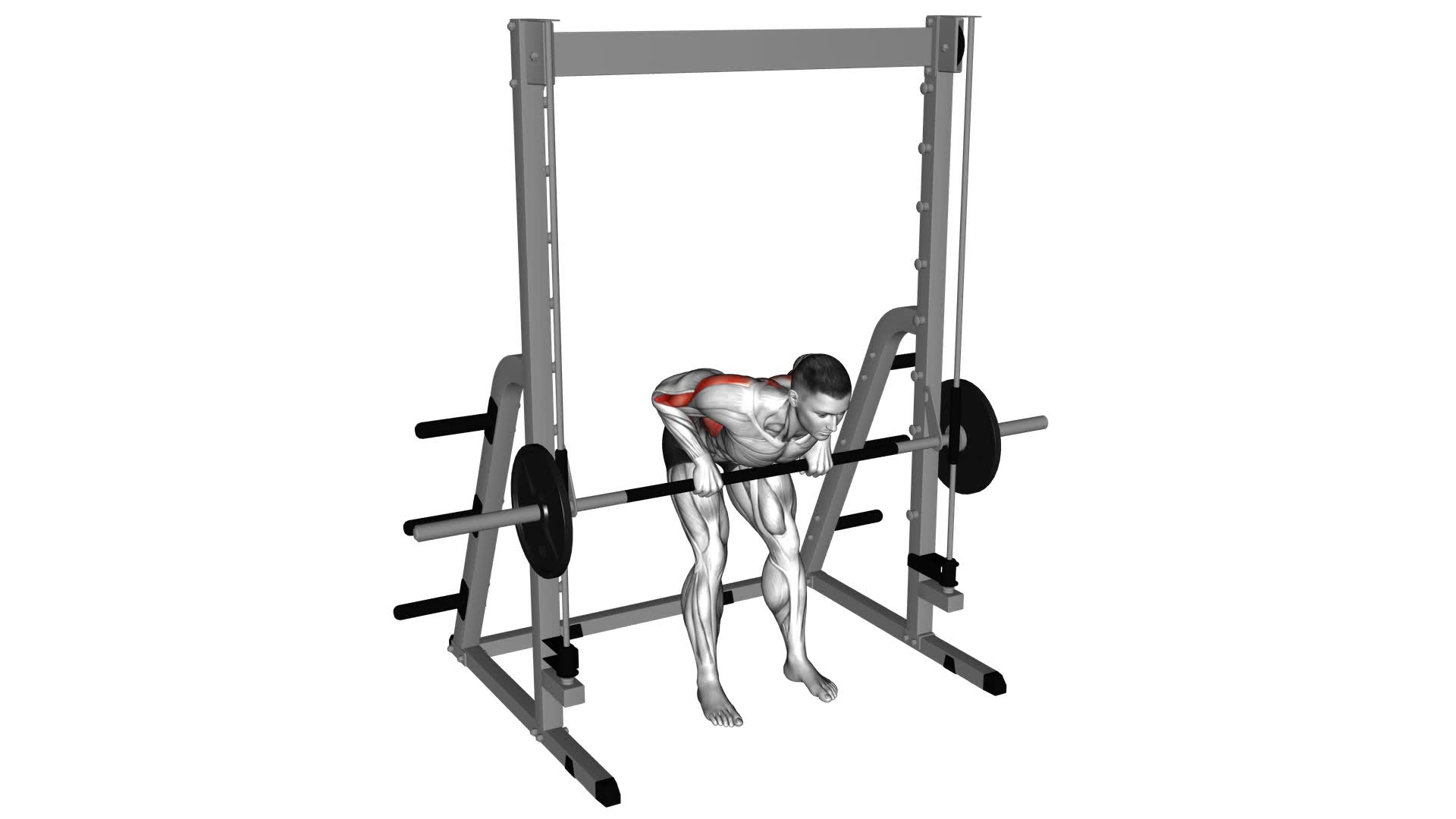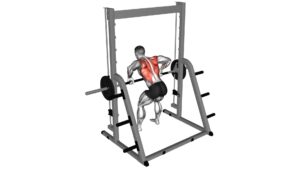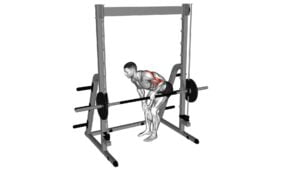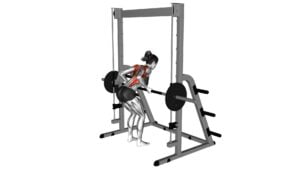Smith Bent Over Row – Video Exercise Guide & Tips

Looking to build strength and target your back muscles? The Smith Bent Over Row is the perfect exercise for you!
Watch This Exercise Video
In this video exercise guide, we'll show you the proper form and technique to maximize your results.
From equipment and setup to common mistakes to avoid, we've got you covered.
Get ready to challenge yourself and achieve your fitness goals with this effective exercise.
Let's get started!
Key Takeaways
- The Smith Bent Over Row is effective for muscle activation and strength gains.
- It targets the muscles of the upper back, including the rhomboids, trapezius, and latissimus dorsi.
- It enhances overall back strength and improves posture.
- It engages the muscles of the biceps and forearms.
Benefits of the Smith Bent Over Row
You should regularly incorporate the Smith Bent Over Row into your workout routine for its numerous benefits.
This exercise is known for its effectiveness in muscle activation and strength gains. The Smith Bent Over Row primarily targets the muscles of the upper back, including the rhomboids, trapezius, and latissimus dorsi. By performing this exercise, you can enhance your overall back strength and improve your posture.
Additionally, the Smith Bent Over Row engages the muscles of the biceps and forearms, providing an excellent opportunity for upper body development.
One of the key benefits of the Smith Bent Over Row is its ability to activate multiple muscle groups simultaneously. This compound movement allows you to work your back, biceps, and forearms all at once, leading to efficient and effective workouts. Furthermore, the increased muscle activation from this exercise translates to greater strength gains over time. By consistently incorporating the Smith Bent Over Row into your routine, you can expect to see improvements in your overall upper body strength and muscle development.
Now that you understand the benefits of the Smith Bent Over Row, let's move on to discussing proper form and technique for optimal results.
Proper Form and Technique
Now let's talk about the important points when it comes to the proper form and technique for the Smith Bent Over Row.
First, you need to focus on your back positioning to ensure that you maintain a neutral spine throughout the exercise.
Secondly, there are different hand grip variations you can try to target different muscles in your back.
Lastly, it's crucial to be aware of common mistakes to avoid, such as using momentum or lifting too heavy, to prevent injuries and maximize the effectiveness of the exercise.
Back Positioning Tips
Maintain proper form and technique for the Smith Bent Over Row by ensuring correct positioning of your back.
Proper back positioning is crucial for maintaining proper posture throughout the exercise. To achieve this, start by standing with your feet shoulder-width apart and your knees slightly bent.
Hinge forward at your hips, maintaining a flat back and a slight arch in your lower back. Keep your chest up and your shoulders back, avoiding any rounding or excessive arching of your spine.
Engage your core muscles to stabilize your body and prevent any excessive swaying or leaning. By maintaining proper back positioning, you'll maximize the effectiveness of the exercise and reduce the risk of injury.
Now, let's move on to the next section and discuss hand grip variations.
Hand Grip Variations
To properly execute the Smith Bent Over Row, it's essential to understand the different hand grip variations and master their proper form and technique. Here are four alternative grips that can help improve your grip strength:
- Overhand Grip: This is the most common grip, where your palms face down and your fingers wrap around the bar. It targets the muscles in your back and biceps.
- Underhand Grip: In this grip, your palms face up, and your fingers wrap around the bar. It shifts the focus to your biceps and forearms.
- Mixed Grip: One hand uses an overhand grip, while the other hand uses an underhand grip. This grip helps with heavier weights and provides better stability.
- Hook Grip: This grip involves wrapping your thumb around the bar first, followed by your fingers. It's commonly used in Olympic weightlifting and can enhance your grip strength.
Common Mistakes to Avoid
To ensure proper form and technique, avoid these common mistakes when performing the Smith Bent Over Row.
First, be mindful of avoiding injuries by maintaining a neutral spine throughout the exercise. Avoid rounding or arching your back, as this can put unnecessary strain on your lower back.
Additionally, make sure to distribute the weight evenly between both feet to keep your balance and stability.
Another mistake to avoid is using too much momentum or jerking the weight up. This not only compromises the effectiveness of the exercise but also increases the risk of injury. Remember to maintain control and focus on the targeted muscles.
Equipment and Setup
For a proper Smith Bent Over Row, you'll need to set up the equipment correctly. Here are four important steps to follow for proper equipment setup:
- Position the Smith machine bar: Adjust the height of the bar on the Smith machine to align with your mid-thigh level. This will ensure that the bar is within reach and at the appropriate height for your bent over row exercise.
- Adjust your body position: Stand with your feet shoulder-width apart, facing the Smith machine. Position yourself with your knees slightly bent and hinge forward at the hips, maintaining a neutral spine. Grip the bar with an overhand grip, slightly wider than shoulder-width apart.
- Ensure proper weight distribution: While performing the Smith Bent Over Row, it's important to distribute your body weight evenly between both feet. This will help maintain stability and balance throughout the exercise.
- Set the weight load: Start with a weight load that's challenging but allows you to maintain proper form. Gradually increase the weight as you become more comfortable and stronger with the exercise.
Common Mistakes to Avoid
Avoiding common mistakes is crucial when performing the Smith Bent Over Row exercise. By being aware of these mistakes and taking steps to prevent them, you can reduce the risk of injury and maximize the effectiveness of your workout.
One common mistake to avoid is using too much weight. It can be tempting to load up the barbell, but using excessive weight can compromise your form and put unnecessary strain on your back and shoulders. Start with a weight that allows you to maintain good form throughout the exercise and gradually increase the weight as you become stronger.
Another mistake to watch out for is rounding your back. This can happen if you're not maintaining proper posture and engaging your core muscles. Keeping your back straight and your core tight will help protect your spine and prevent injury.
Lastly, avoid jerking or using momentum to lift the weight. This not only reduces the effectiveness of the exercise, but it also increases the risk of injury. Focus on using controlled movements and contracting your back muscles to lift the weight.
Variations and Modifications
Looking to add variety to your Smith Bent Over Row routine? Here are four variations and modifications you can try to challenge yourself and target different muscle groups:
- Single-arm Smith Bent Over Row: Instead of using both arms simultaneously, perform the exercise with one arm at a time. This progression helps improve unilateral strength and stability.
- Wide-grip Smith Bent Over Row: Place your hands wider apart on the barbell to increase the emphasis on the upper back muscles, such as the latissimus dorsi.
- Reverse-grip Smith Bent Over Row: Switch your grip so that your palms are facing up. This modification shifts the focus to the biceps, forearms, and upper back muscles, providing a different stimulus to your routine.
- Inverted Smith Bent Over Row: Lie face-up on a bench and perform the rowing motion with the Smith machine barbell. This variation engages the upper back muscles from a different angle and challenges your core stability.
By incorporating these progressions and equipment options into your Smith Bent Over Row routine, you can keep your workouts fresh and continue making progress.
Now, let's move on to the next section where we'll discuss tips for maximizing results.
Tips for Maximizing Results
To maximize your results with the Smith Bent Over Row, it's important to focus on proper form. This ensures that you're engaging the target muscles effectively and minimizing the risk of injury.
Additionally, optimizing your training frequency will allow for adequate recovery and muscle growth.
Proper Form Importance
Make sure you maintain proper form during the Smith Bent Over Row exercise to maximize your results. Proper form is crucial for targeting the back muscles effectively and avoiding injury.
Here are some tips to help you maintain proper form:
- Keep your back straight: Avoid rounding your back as it can strain your lower back and reduce the effectiveness of the exercise.
- Engage your core: Tighten your abdominal muscles to stabilize your spine and maintain a neutral position.
- Squeeze your shoulder blades: Focus on retracting your shoulder blades together at the top of the movement to engage your back muscles fully.
- Control the weight: Avoid using momentum and instead, focus on a slow and controlled movement to ensure proper muscle activation.
By following these tips, you can ensure that you're targeting your back muscles effectively and maximizing your results.
Now, let's move on to discussing the engagement of the target muscles.
Target Muscle Engagement
Engage your target muscles fully by focusing on proper form and technique during the Smith Bent Over Row exercise. The importance of proper form can't be overstated when it comes to maximizing the benefits of this exercise.
By maintaining a stable core, keeping your back straight, and pulling the bar towards your lower abdomen, you ensure that your target muscles, such as the latissimus dorsi and rhomboids, are properly activated.
Additionally, using muscle activation techniques like squeezing your shoulder blades together and initiating the movement from your back muscles rather than your arms can further enhance the engagement of your target muscles.
Remember to start with a weight that allows you to maintain proper form throughout the exercise and gradually increase the weight as your strength and form improve.
Training Frequency Optimization
For optimal results, it's important to consider the frequency of your Smith Bent Over Row training sessions. Maximizing gains requires finding the right balance between rest and exercise. Here are four tips to help you optimize your training frequency:
- Consistency is key: Aim for at least two to three sessions per week to maintain progress and build strength over time.
- Listen to your body: Pay attention to how your muscles feel after each session. If you're experiencing excessive soreness or fatigue, it may be a sign to decrease the frequency or intensity of your workouts.
- Gradually increase volume: Start with a manageable training frequency and gradually increase the number of sessions as your strength and endurance improve. This approach allows your body to adapt and prevents overtraining.
- Include rest days: Rest days are essential for muscle recovery and growth. Incorporate one to two rest days between Smith Bent Over Row sessions to give your muscles time to repair and rebuild.
Frequently Asked Questions
Is the Smith Bent Over Row Suitable for Beginners or More Advanced Lifters?
The Smith Bent Over Row is a versatile exercise that can be adapted for both beginners and advanced lifters.
For beginners, modifications can be made by using lighter weights and focusing on proper form. This exercise helps to strengthen the back muscles, improve posture, and increase overall upper body strength.
Advanced lifters can benefit from the Smith Bent Over Row by using heavier weights and incorporating it into their routine to target specific muscles in the back and arms.
Can the Smith Bent Over Row Be Performed With a Barbell Instead of a Smith Machine?
Yes, you can perform the Smith Bent Over Row with a barbell instead of a Smith machine.
The main difference between the two is that the Smith machine provides a fixed path of motion, while the barbell row allows for more freedom of movement.
Using a barbell requires more stabilization and engages additional muscles, making it a great exercise for building upper body strength.
Just make sure to maintain proper form and technique to avoid injury.
How Often Should the Smith Bent Over Row Be Incorporated Into a Workout Routine?
Incorporating the Smith Bent Over Row into your workout routine has numerous benefits. It targets your back muscles, helping to improve strength and posture.
It can be done with variations and modifications to suit different fitness levels. Adding this exercise to your routine can help you achieve a well-rounded upper body workout.
Remember to start with lighter weights and focus on proper form to avoid injury.
Are There Any Alternative Exercises That Target the Same Muscle Groups as the Smith Bent Over Row?
If you're looking for alternative exercises that target the same muscle groups as the Smith Bent Over Row, there are a few options you can consider.
Some exercises that work similar muscles include the barbell bent over row, dumbbell bent over row, and the cable row.
These exercises can help you strengthen your back muscles, including the lats, rhomboids, and traps.
Incorporating these alternatives into your workout routine can provide variety and help you continue to challenge your muscles.
Can the Smith Bent Over Row Help Improve Posture or Alleviate Back Pain?
To improve your posture and alleviate back pain, the Smith Bent Over Row can be beneficial.
This exercise targets the muscles in your back, including the rhomboids, trapezius, and latissimus dorsi. By strengthening these muscles, you can support your spine and improve your overall posture.
Additionally, the Smith Bent Over Row helps to alleviate back pain by promoting proper alignment and reducing muscle imbalances.
Incorporate this exercise into your routine for better posture and back pain relief.
Conclusion
In conclusion, the Smith Bent Over Row is a highly effective exercise for building strength in the back and upper body. By maintaining proper form and technique, using the appropriate equipment and setup, and avoiding common mistakes, you can maximize the benefits of this exercise.
Additionally, incorporating variations and modifications, as well as following the provided tips, will help you achieve optimal results. Start incorporating the Smith Bent Over Row into your workout routine for a stronger and more defined upper body.

Author
Years ago, the spark of my life’s passion ignited in my mind the moment I stepped into the local gym for the first time. The inaugural bead of perspiration, the initial endeavor, the very first surge of endorphins, and a sense of pride that washed over me post-workout marked the beginning of my deep-seated interest in strength sports, fitness, and sports nutrition. This very curiosity blossomed rapidly into a profound fascination, propelling me to earn a Master’s degree in Physical Education from the Academy of Physical Education in Krakow, followed by a Sports Manager diploma from the Jagiellonian University. My journey of growth led me to gain more specialized qualifications, such as being a certified personal trainer with a focus on sports dietetics, a lifeguard, and an instructor for wellness and corrective gymnastics. Theoretical knowledge paired seamlessly with practical experience, reinforcing my belief that the transformation of individuals under my guidance was also a reflection of my personal growth. This belief holds true even today. Each day, I strive to push the boundaries and explore new realms. These realms gently elevate me to greater heights. The unique combination of passion for my field and the continuous quest for growth fuels my drive to break new ground.







